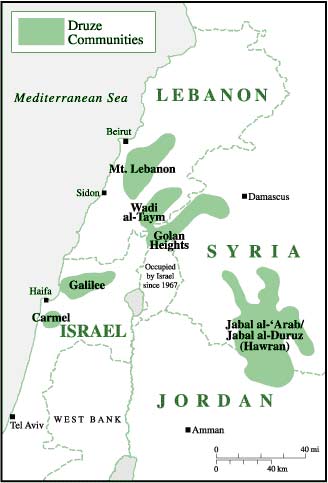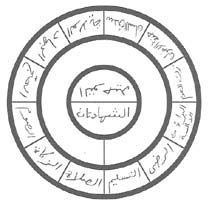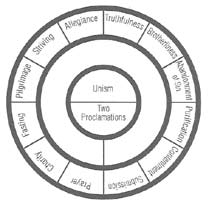|
the story of the druzes
While doing my research to write this paper, I ran into so many different versions of explaining the Druze Faith. Yet, they all came together on one thing; the Druzes have developed a fierce loyalty to each other because of their isolation; they have sustained for one thousand years.
The Druzes One Thousand Years of Tradition and Reform
This article was published in Intercom, the International Studies and Overseas
Programes' newsletter. Vol. 21, No. 1. October 1998.
The Druzes are a Middle Eastern minority group with their formal origins in the 11th century. They are perhaps one of the most misunderstood and understudied religious sects in the world. Most Druzes live today in mountainous regions in Lebanon, Syria, Israel, and Jordan. Taking all available figures into consideration, the Druze population is nearly one million with 40%-50% living in Syria, 30%-40% in Lebanon, 6%-7% in Israel, and 1%-2% in Jordan. In the U.S. there are approximately 20,000 Druzes.
During the 19th and early 20th centuries Druze immigrant communities were established around the world and could be found in Australia, Canada, Europe, the Philippines, South and Central America, the United States, and West Africa. Like many other immigrants, they strive to preserve their traditions and maintain frequent contact with co-religionists. In the United States, for example, the American Druze Society (ADS) has organized annual conventions since 1946 and, more recently, established its main center in Eagle Rock, California. In fact, Southern California is home of the largest concentration of Druzes in the U.S |
 |
Druze Origins: 1000 Years of History
Historians trace Druze origins to 11th century Fatimid Cairo where they began as an Islamic reform movement. The establishment of this reform movement and doctrine revolves primarily around several individuals, two of whom are Hakim and Hamza. A third individual, named Darazi, is thought to be responsible for undermining the doctrine and ironically lending his name to the sect itself. Hakim was the 6th Fatimid Caliph who became the head of the Islamic Fatimid state in 996 at the age of eleven. Although Hakim’s attitude towards the emerging reform movement that later became known as ‘Druze’ is not fully discernible from available sources, he is regarded within the Druze manuscripts as the founding father of Druzism and the source of its strict unitarianism. Among the reforms he introduced were resolutions to (1) abolish slavery, (2) prohibit polygamy, and (3) implement a form of separation of church and state. While these reforms did not become part of orthodox Islam, the Druzes, as well as other Islamic sectarian movements, adopted them.
The connection between Hakim and the Druzes is best substantiated through the religious writings of Hamza, the second person associated with the Druze faith, who was appointed as a religious leader by Hakim. He is considered the main author behind most of the original Druze manuscripts. After a period of teaching philosophy and religion, Hamza began to organize followers, train missionaries, and write a religious doctrine. Prospective adherents were requested to pledge their loyalty to a form of strict unitarianism (Tawhid), a reform doctrine with a new interpretation of some aspects of Islam and monotheism in general.
The resistance of the medieval populace to such interpretation, however, posed a grave danger for Hamza and his associates. One of Hamza’s subordinates, Darazi, seized the opportunity to take political control of the movement and proclaimed himself “Guide of guides” which was meant to elevate him over Hamza.
More importantly, Darazi began to falsify the doctrine of Tawhid by altering a number of Hamza’s writings. Darazi was ultimately executed by Hakim in 1019. Nonetheless, some of Darazi’s teachings were attributed to the Druzes by his followers, referred to as “Darazis.” Ironically, a few medieval chroniclers of the time not only failed to make the distinction between Druzes and Darazis but attributed Darazi’s doctrine to the followers of Hamza and argued that Hakim supported Darazi’s ideas. Other historians have reported that it was Hamza who was subordinate to Darazi, and still others have referred to Hamza and Darazi as the same person: Hamza al-Darazi. As a consequence, the name “Druze” became synonymous with the reform movement. Despite the ironic and misleading origins of the sect’s name, the title “Druze” never occurs in the Druze manuscripts of the 11th century. After the execution of Darazi and his collaborators, Hamza continued his preaching activities for two more years. Among Druzes today, Darazi is known as a heretic and the uttering of his name constitutes the use of profanity.
Druze Society: Dualistic Structure
 
Although the structure of the Druze society helps unite them into a socially cohesive community, it also divides them into two main classes: “the initiated” known in Arabic as ‘uqqal, literally “wise,” who are familiar with the religious teachings; and “the uninitiated” known as juhhal, or literally “ignorant” who are not initiated in the Druze doctrine. Only those members of the community who demonstrate piety and devotion and who have withstood a lengthy process of candidacy are initiated into the teachings of the Druze faith. Women may also be initiated in the Druze doctrine. The Druze tradition considers women to be more spiritually prepared than men to enter such circles because they are considered less likely to be exposed to deviant or immoral practices such as murder and adultery.
The initiated male and female members of the Druze community are easily identified by their dark clothes and white head covers. They meet in the Druze house of worship called khalwa or place of solitude for recitation of the religious doctrine and other social and general community discussions. The initiated are further subdivided into a number of categories based on their level of advancement in religious knowledge. One group receives its status as the result of being considered the most knowledgeable and devout of their community. Known as ajaweed, or “the good,” these individuals occupy the most honored position in Druze society. Whenever issues concerning the conduct of adherents of the sect arise, the opinions of this religious elite are highly regarded. Other members of the community listen when the ajaweed speak, act according to their directives, and stand respectfully when they walk away. The ajaweed not only provide exclusive authority on Druze religious doctrine, they also prescribe the accepted cultural norms of the community, shaping its character and reinforcing the members’ interactions within their families, villages, and with the rest of the world.
Uninitiated Druzes comprise the majority of the society. Though they are not familiar with the specifics of the Druze religious doctrine, their behavior is expected to conform with certain prescriptions, both spiritual (e.g. fealty to God and His prophets) and moral (e.g. respect for elders and honor for women). Those who are uninitiated may seek initiation at any stage of their lives, but their acceptance in the ranks of the initiated is based on their moral character and their conduct in the Druze community.
The interaction between the initiated and uninitiated provides a dualistic communal structure and facilitates the cohesiveness and unity of the Druze community in times of peace as well as war by shaping the social and political behavior of members of the Druze society. In this dualistic setting, religious leadership is generally provided by the initiated and political and military leadership is often exercised by the uninitiated. The initiated prescribe and model the accepted standards for the community while the uninitiated draw strength from, as well as provide protection for, the initiated and the way of life, beliefs, and values they represent.
Druzes also exhibit what may be called “familial dualism” or dualism rooted in family relations. Druze families often form two competing factions behind two of the largest families or even behind two brothers or cousins within the same family. Each faction negotiates its own interests on behalf of the community, which generally benefits both sides.
In Druze society, as in Middle Eastern culture in general, the priority of the family over the individual is predominant. Druzes build their houses when possible on land adjacent to their parents, and extended families usually remain in close proximity to one another. Decisions are often made in consultation with other members of the family on matters such as whether to buy a motorcycle, car, or truck, and, in previous centuries, whether to buy a horse, donkey, or camel. The more important the decision, the greater the number of family members involved in the decision-making process.
Druze Beliefs: Profoundly Monotheistic
Most monotheists believe in exoteric or literal meanings of their scriptures while some speak of esoteric or inner meanings. The mystical tradition in Islam, Judaism, and Christianity also attempts esoteric reading or interpretation of the scriptures. Druzes believe that both the Bible and the Qur’an have esoteric meanings in addition to the exoteric or literal ones. Moreover, Druzes also believe that above these two levels of meaning there is “the esoteric of the esoteric.” In Druze faith, there are prophets, helpers, and luminaries. Each fulfills a different function in achieving complete spirituality.
For example, Druzes venerate the messages of prophets in the Judaeo-Christian and Islamic traditions, who preached the word of God in their respective lifetimes. Each prophet, according to Druzes, preached only a partial truth since humanity was not yet ready to receive the entire truth. However, underneath the exoteric truth lay the esoteric message. For each of these prophets, God provided a helper or assistant to propagate the doctrine of strict unitarianism and to interpret the esoteric nature of the message. For each period, Druzes argue there were also luminaries who taught these three levels of interpretations.
The Druze doctrine contains rich examples outlining specific moral lessons and rules of individual and communal conduct that are found in approximately thirty manuscripts. Most scholars have mistakenly referred to only one single manuscript, The Epistles of Wisdom, as embodying the complete Druze scriptures. Some have included an additional two to three manuscripts. This writer has documented 23 manuscripts showing the impact and importance of each on Druze identity.
For nearly 1,000 years, Druzes have preserved their beliefs and traditions as outlined in the manuscripts written between 1017-1043. Their doctrine and dualistic structure have persisted despite the changes that their community has undergone.
Additional links:
www.druzestudies.org/
www.druzehistoryandculture.com
|


